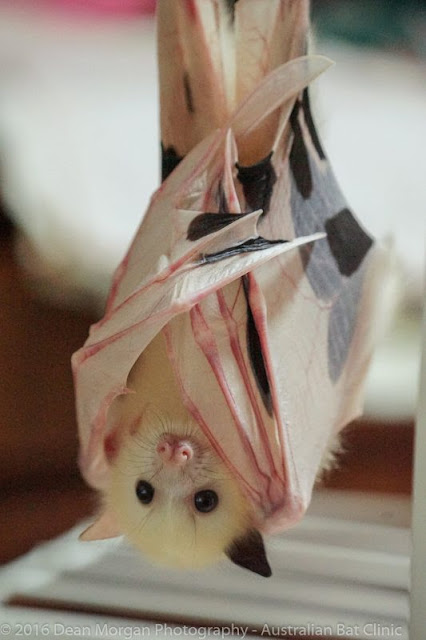Tal'ngai Dha'run | Breathtaking photos of rare Australian Bat will inspire you to protect this species | Megabat | Leucistic Grey-headed (Flying-fox) (Fruit bat) (Leucism) 04022017
Some people might view bats as terrifying creatures but in reality, that’s not the case. We know that many animals are unfortunately given bad reputations because of our misconceptions about them, and bats are one example of this. Most bats pose little or no threat to humans and are actually quite beneficial to us. For instance, one brown bat – about the size of a human thumb – can consume about 600 mosquitoes and other unwanted insects an hour. Amazing!
Sadly, bat populations are in decline. Many bat species are in danger of extinction due to habitat loss, culls, and fatal white-nose syndrome. White-nose syndrome is a form of fungus that grows on bats when they are hibernating. So far, six million bats have died from this disease.
Australian Bat Clinic and Wildlife Trauma Centre, located in Queensland, Australia is working towards changing the misconceptions about bats. The organization aims to care for injured and orphaned bats, and they currently have a very unique Grey Headed Flying Fox, named Tal’ngai Dha’run, in their care. They believe this little one has leucism, a condition that causes partial loss of pigmentation in an animal resulting in white, pale, or patchy coloration of the skin, hair, feathers, scales or cuticle, but not the eyes. Not only is this one incredibly rare, but they believe he might just be the only one who exists! His condition hasn’t stopped him from making friends or interacting with his caretakers, though. The clinic’s staff report he is a total lovebug. Check out these stunning photos!
Tal’ngai Dha’run is not only a gorgeous guy, but he plays a critical role in our ecosystem. Bats can eat millions of bugs in one night which means that farmers don’t have to use as much pesticide when bats are around. Bats are also pollinators.
Nectar-eating bats are crucial pollinators for over 500 plant species, many of which are ecologically significant. Most flowering plants do not have the ability to produce seeds without being pollinated. When bats drink a flower’s nectar, they subsequently pick up pollen and transfer it as they feed.
According to the Australian Bat Clinic and Rescue Centre, Tal’ngai Dha’run’s nose is shaped like that “because they squeeze the juice out of fruit while hanging upside down, and that nose design stops juice from running up their noses.” Pretty cool!
Instead of fearing bats, we should work to protect them. The first step is to raise awareness about their plight. Tal’ngai Dha’run is not scary, he is amazing!
Please share this post with your friends and family to help us dispel the myths about these wonderful creatures. Even though the general public fears bats, the truth is that we need them more than most imagine. For more information on Australian Bat Clinic and Rescue Centre and how to make a donation to continue their life saving missions, click here.
All Image Source: Dean Morgan Photography/Facebook











sm done https://www.facebook.com/TalngaiDharun/
ReplyDelete